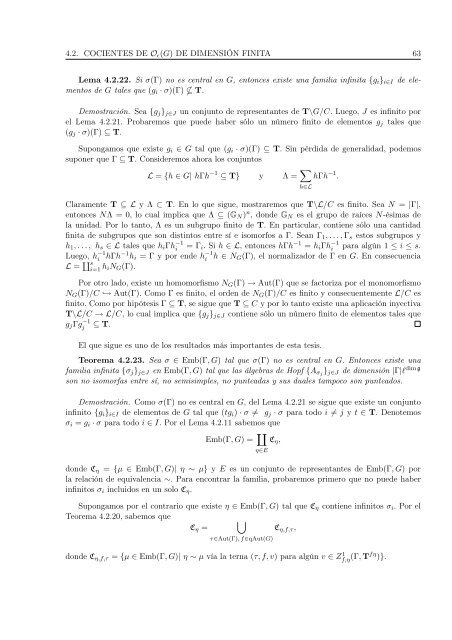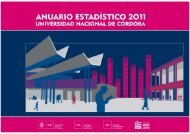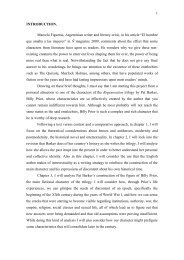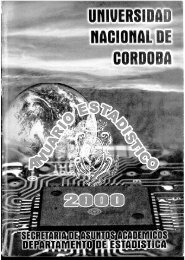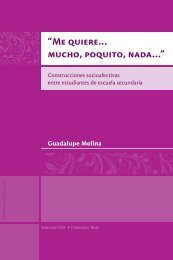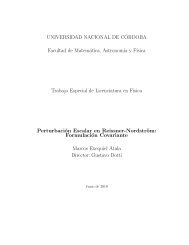Abrir - RDU - Universidad Nacional de Córdoba
Abrir - RDU - Universidad Nacional de Córdoba
Abrir - RDU - Universidad Nacional de Córdoba
You also want an ePaper? Increase the reach of your titles
YUMPU automatically turns print PDFs into web optimized ePapers that Google loves.
4.2. COCIENTES DE O ɛ (G) DE DIMENSIÓN FINITA 63<br />
Lema 4.2.22. Si σ(Γ) no es central en G, entonces existe una familia infinita {g i } i∈I <strong>de</strong> elementos<br />
<strong>de</strong> G tales que (g i · σ)(Γ) T.<br />
Demostración. Sea {g j } j∈J un conjunto <strong>de</strong> representantes <strong>de</strong> T\G/C. Luego, J es infinito por<br />
el Lema 4.2.21. Probaremos que pue<strong>de</strong> haber sólo un número finito <strong>de</strong> elementos g j tales que<br />
(g j · σ)(Γ) ⊆ T.<br />
Supongamos que existe g i ∈ G tal que (g i · σ)(Γ) ⊆ T. Sin pérdida <strong>de</strong> generalidad, po<strong>de</strong>mos<br />
suponer que Γ ⊆ T. Consi<strong>de</strong>remos ahora los conjuntos<br />
L = {h ∈ G| hΓh −1 ⊆ T} y Λ = ∑ h∈L<br />
hΓh −1 .<br />
Claramente T ⊆ L y Λ ⊂ T. En lo que sigue, mostraremos que T\L/C es finito. Sea N = |Γ|,<br />
entonces NΛ = 0, lo cual implica que Λ ⊆ (G N ) n , don<strong>de</strong> G N es el grupo <strong>de</strong> raíces N-ésimas <strong>de</strong><br />
la unidad. Por lo tanto, Λ es un subgrupo finito <strong>de</strong> T. En particular, contiene sólo una cantidad<br />
finita <strong>de</strong> subgrupos que son distintos entre sí e isomorfos a Γ. Sean Γ 1 , . . . , Γ s estos subgrupos y<br />
h 1 , . . . , h s ∈ L tales que h i Γh −1<br />
i<br />
= Γ i . Si h ∈ L, entonces hΓh −1 = h i Γh −1<br />
i<br />
para algún 1 ≤ i ≤ s.<br />
Luego, h −1<br />
i<br />
hΓh −1 h i = Γ y por en<strong>de</strong> h −1<br />
i<br />
h ∈ N G (Γ), el normalizador <strong>de</strong> Γ en G. En consecuencia<br />
L = ∐ s<br />
i=1 h iN G (Γ).<br />
Por otro lado, existe un homomorfismo N G (Γ) → Aut(Γ) que se factoriza por el monomorfismo<br />
N G (Γ)/C ↩→ Aut(Γ). Como Γ es finito, el or<strong>de</strong>n <strong>de</strong> N G (Γ)/C es finito y consecuentemente L/C es<br />
finito. Como por hipótesis Γ ⊆ T, se sigue que T ⊆ C y por lo tanto existe una aplicación inyectiva<br />
T\L/C → L/C, lo cual implica que {g j } j∈J contiene sólo un número finito <strong>de</strong> elementos tales que<br />
g j Γg −1<br />
j<br />
⊆ T.<br />
El que sigue es uno <strong>de</strong> los resultados más importantes <strong>de</strong> esta tesis.<br />
Teorema 4.2.23. Sea σ ∈ Emb(Γ, G) tal que σ(Γ) no es central en G. Entonces existe una<br />
familia infinita {σ j } j∈J en Emb(Γ, G) tal que las álgebras <strong>de</strong> Hopf {A σj } j∈J <strong>de</strong> dimensión |Γ|l dim g<br />
son no isomorfas entre sí, no semisimples, no punteadas y sus duales tampoco son punteados.<br />
Demostración. Como σ(Γ) no es central en G, <strong>de</strong>l Lema 4.2.21 se sigue que existe un conjunto<br />
infinito {g i } i∈I <strong>de</strong> elementos <strong>de</strong> G tal que (tg i ) · σ ≠ g j · σ para todo i ≠ j y t ∈ T. Denotemos<br />
σ i = g i · σ para todo i ∈ I. Por el Lema 4.2.11 sabemos que<br />
Emb(Γ, G) = ∐ η∈E<br />
C η ,<br />
don<strong>de</strong> C η = {µ ∈ Emb(Γ, G)| η ∼ µ} y E es un conjunto <strong>de</strong> representantes <strong>de</strong> Emb(Γ, G) por<br />
la relación <strong>de</strong> equivalencia ∼. Para encontrar la familia, probaremos primero que no pue<strong>de</strong> haber<br />
infinitos σ i incluidos en un solo C η .<br />
Supongamos por el contrario que existe η ∈ Emb(Γ, G) tal que C η contiene infinitos σ i . Por el<br />
Teorema 4.2.20, sabemos que<br />
⋃<br />
C η =<br />
C η,f,τ ,<br />
τ∈Aut(Γ), f∈qAut(G)<br />
don<strong>de</strong> C η,f,τ = {µ ∈ Emb(Γ, G)| η ∼ µ vía la terna (τ, f, v) para algún v ∈ Z 1 f,η (Γ, Tfη )}.


